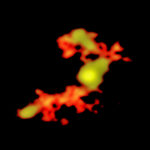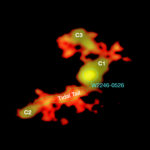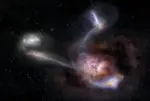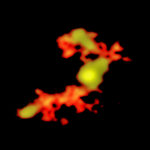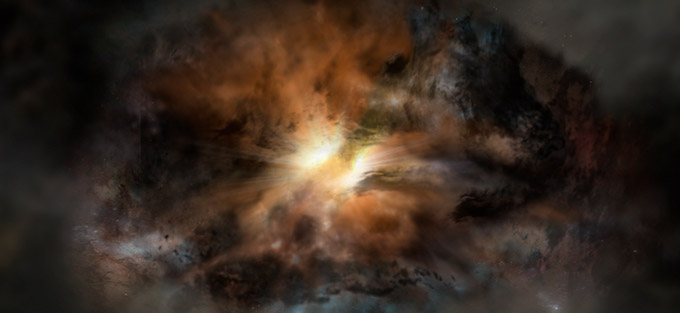Trans-galactic Streamers Feeding Most Luminous Galaxy in the Universe
The most luminous galaxy in the universe has been caught in the act of stripping away nearly half the mass from not one, not two, but at least three of its smaller neighbors, according to new Atacama Large Millimeter/submillimeter Array (ALMA) observations published in the journal Science. The light from this galaxy, known as W2246-0526, took 12.4 billion years to reach us, so we see it as it was when our universe was only a tenth of its present age.
Trans-galactic Streamers Feeding Most Luminous Galaxy in the Universe from ALMA Observatory on Vimeo.
The new observations with ALMA reveal distinct streamers of material being pulled from three smaller galaxies and flowing into the more massive galaxy, which was discovered in 2015 by NASA's space-based Wide-field Infrared Survey Explorer (WISE). It is by no means the largest or most enormous galaxy we know of, but it is unrivaled in its brightness, emitting as much infrared light as 350 trillion Suns.
The connecting tendrils between the galaxies contain about as much material as the galaxies themselves. ALMA’s amazing resolution and sensitivity allowed the researchers to detect these remarkably faint and distant trans-galactic streamers.
“We knew from previous data that there were three companion galaxies, but there was no evidence of interactions between these neighbors and the central source,” said Tanio Diaz-Santos of the Universidad Diego Portales in Santiago, Chile, lead author of the study. “We weren't looking for cannibalistic behavior and weren't expecting it, but this deep dive with the ALMA observatory makes it very clear.”
Galactic cannibalism is not uncommon, though this is the most distant galaxy in which such behavior has been observed, and the study authors are not aware of any other direct images of a galaxy simultaneously feeding on material from multiple sources at those early cosmic times.
The researchers emphasize that the amount of gas being devoured by W2246-0526 is enough to keep it forming stars and feeding its central black hole for hundreds of millions of years.
This galaxy’s startling luminosity is not due to its individual stars. Instead, its brightness is powered by a tiny, yet fantastically energetic disk of gas that is being superheated as it spirals in on the supermassive black hole. The light from this blazingly bright accretion disk is then absorbed by the surrounding dust, which re-emits the energy as infrared light.
The material from the accretion disks falls onto the black hole powering the Active Galactic Nuclei (AGN), making this galaxy one of a rare class of quasars known as Hot, Dust-Obscured Galaxies (Hot DOGs). Only about one out of every 3,000 quasars observed by WISE belongs to this class.
Much of the dust and gas being siphoned away from the three smaller galaxies is likely being converted into new stars and feeding the more massive galaxy’s central black hole. This galaxy's gluttony, however, may lead to self-destruction. Previous research suggests that the energy of the AGN will ultimately jettison much if not all of the galaxy’s star-forming fuel.
An earlier work led by co-author Chao-Wei Tsai estimates that the black hole at the center of W2246-0526 is about 4 billion times the mass of the Sun. The mass of the black hole directly influences how bright the AGN can become, but the paper shows that W2246-0526 is about three times more luminous than what should be possible. Solving this apparent contradiction will require more observations.
Additional Information
This research is presented in a paper titled “The Multiple Merger Assembly of a Hyper-luminous Obscured Quasar at redshift 4.6” by T. Díaz-Santos et al. in Science.
The research team was composed by T. Díaz-Santos [1], R. J. Assef [1], A. W. Blain [2], M. Aravena [1], D. Stern [3], C.-W. Tsai [4], P. Eisenhardt [3], J. Wu [5], H. Jun [6], K. Dibert [7], H. Inami [8], G. Lansbury [9], F. Leclercq [8].
[1] Núcleo de Astronomía, Facultad de Ingeniería y Ciencias. Universidad Diego Portales, Ejército Libertador 441, Santiago, 8320000, Chile.
[2] University of Leicester, Physics and Astronomy, University Road, Leicester LE1 7RH, UK.
[3] Jet Propulsion Laboratory, California Institute of Technology, 4800 Oak Grove Dr., Pasadena, CA 91109, USA.
[4] Department of Physics and Astronomy, University of California, Los Angeles, CA 90095, USA.
[5] National Astronomical Observatories, Chinese Academy of Sciences, 20A Datun Road, Chaoyang District, Beijing 100012, China.
[6] School of Physics, Korea Institute for Advanced Study, 85 Hoegiro, Dongdaemun-gu, Seoul 02455, Korea.
[7] Department of Physics, Massachusetts Institute of Technology, 77 Massachusetts Avenue, Cambridge, MA, 02139, USA.
[8] Univ Lyon, Univ Lyon1, École Normale Supérieure de Lyon, Centre National de la Recherche Scientifique, Centre de Recherche Astrophysique de Lyon UMR5574, F-6~9230, Saint-Genis- Laval, France.
[9] Institute of Astronomy, University of Cambridge, Madingley Road, Cambridge, CB3 0HA, UK.
The Atacama Large Millimeter/submillimeter Array (ALMA), an international astronomy facility, is a partnership of the European Organisation for Astronomical Research in the Southern Hemisphere (ESO), the U.S. National Science Foundation (NSF) and the National Institutes of Natural Sciences (NINS) of Japan in cooperation with the Republic of Chile. ALMA is funded by ESO on behalf of its Member States, by NSF in cooperation with the National Research Council of Canada (NRC) and the National Science Council of Taiwan (NSC) and by NINS in cooperation with the Academia Sinica (AS) in Taiwan and the Korea Astronomy and Space Science Institute (KASI).
ALMA construction and operations are led by ESO on behalf of its Member States; by the National Radio Astronomy Observatory (NRAO), managed by Associated Universities, Inc. (AUI), on behalf of North America; and by the National Astronomical Observatory of Japan (NAOJ) on behalf of East Asia. The Joint ALMA Observatory (JAO) provides the unified leadership and management of the construction, commissioning and operation of ALMA.
NASA's Jet Propulsion Laboratory in Pasadena, California, managed and operated WISE for NASA's Science Mission Directorate in Washington. The spacecraft operated until 2011. In September 2013, WISE was reactivated, renamed NEOWISE and assigned a new mission to assist NASA's efforts to identify potentially hazardous near-Earth objects.
Additional Information
This research is presented in a paper titled “The Multiple Merger Assembly of a Hyper-luminous Obscured Quasar at redshift 4.6” by T. Díaz-Santos et al. in Science.
The research team was composed by T. Díaz-Santos [1], R. J. Assef [1], A. W. Blain [2], M. Aravena [1], D. Stern [3], C.-W. Tsai [4], P. Eisenhardt [3], J. Wu [5], H. Jun [6], K. Dibert [7], H. Inami [8], G. Lansbury [9], F. Leclercq [8].
[1] Núcleo de Astronomía, Facultad de Ingeniería y Ciencias. Universidad Diego Portales, Ejército Libertador 441, Santiago, 8320000, Chile.
[2] University of Leicester, Physics and Astronomy, University Road, Leicester LE1 7RH, UK.
[3] Jet Propulsion Laboratory, California Institute of Technology, 4800 Oak Grove Dr., Pasadena, CA 91109, USA.
[4] Department of Physics and Astronomy, University of California, Los Angeles, CA 90095, USA.
[5] National Astronomical Observatories, Chinese Academy of Sciences, 20A Datun Road, Chaoyang District, Beijing 100012, China.
[6] School of Physics, Korea Institute for Advanced Study, 85 Hoegiro, Dongdaemun-gu, Seoul 02455, Korea.
[7] Department of Physics, Massachusetts Institute of Technology, 77 Massachusetts Avenue, Cambridge, MA, 02139, USA.
[8] Univ Lyon, Univ Lyon1, École Normale Supérieure de Lyon, Centre National de la Recherche Scientifique, Centre de Recherche Astrophysique de Lyon UMR5574, F-6~9230, Saint-Genis- Laval, France.
[9] Institute of Astronomy, University of Cambridge, Madingley Road, Cambridge, CB3 0HA, UK.
The Atacama Large Millimeter/submillimeter Array (ALMA), an international astronomy facility, is a partnership of the European Organisation for Astronomical Research in the Southern Hemisphere (ESO), the U.S. National Science Foundation (NSF) and the National Institutes of Natural Sciences (NINS) of Japan in cooperation with the Republic of Chile. ALMA is funded by ESO on behalf of its Member States, by NSF in cooperation with the National Research Council of Canada (NRC) and the Ministry of Science and Technology (MOST) in Taiwan and by NINS in cooperation with the Academia Sinica (AS) in Taiwan and the Korea Astronomy and Space Science Institute (KASI).
ALMA construction and operations are led by ESO on behalf of its Member States; by the National Radio Astronomy Observatory (NRAO), managed by Associated Universities, Inc. (AUI), on behalf of North America; and by the National Astronomical Observatory of Japan (NAOJ) on behalf of East Asia. The Joint ALMA Observatory (JAO) provides the unified leadership and management of the construction, commissioning and operation of ALMA.
NASA's Jet Propulsion Laboratory in Pasadena, California, managed and operated WISE for NASA's Science Mission Directorate in Washington. The spacecraft operated until 2011. In September 2013, WISE was reactivated, renamed NEOWISE and assigned a new mission to assist NASA's efforts to identify potentially hazardous near-Earth objects.
Images
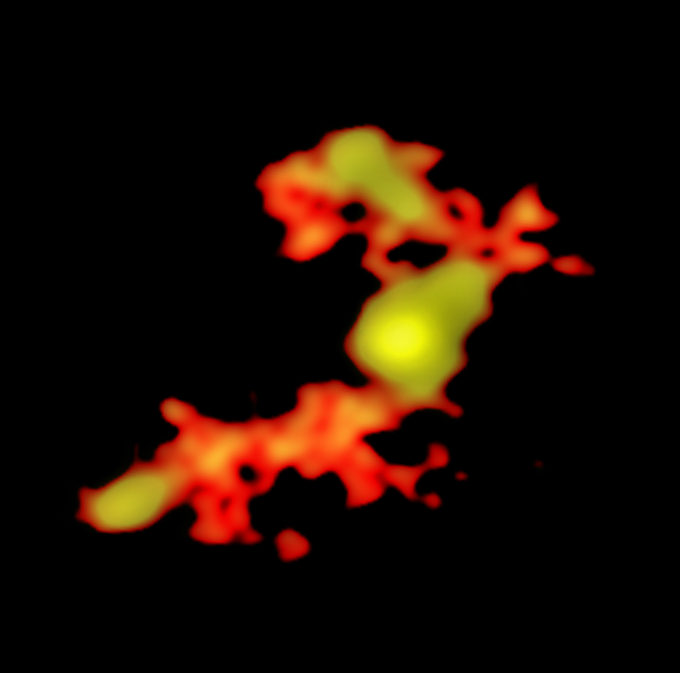
ALMA image of W2246-0526 and its companions feeding it through trans-galactic streamers. Credit: T. Diaz-Santos et al.; N. Lira; ALMA (ESO/NAOJ/NRAO).
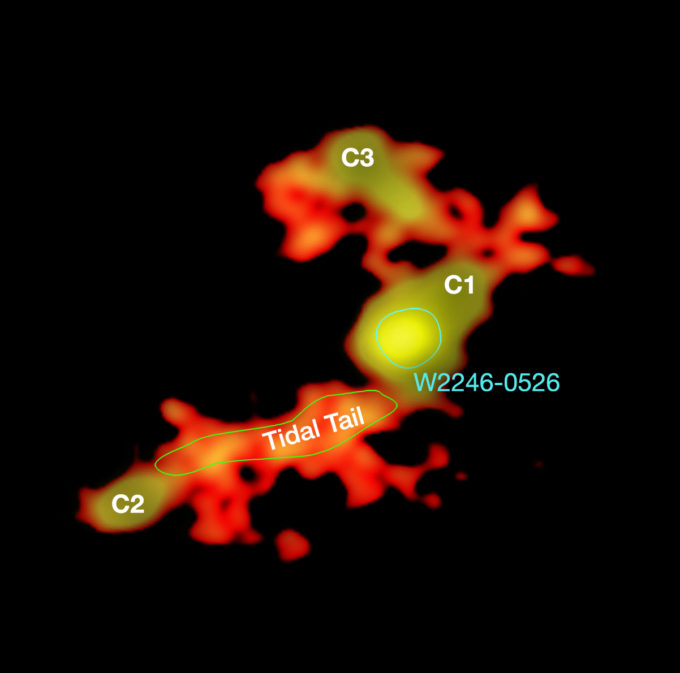
ALMA image shows how W2246-0526 is being fed by three companion galaxies (C1, C2, and C3) through trans-galactic streamers: a large tidal tail, labeled in green, connects C2 with the main galaxy; the other two galaxies (C1 and C3) are connected to W2246-0526 by dust bridges. Credit: T. Diaz-Santos et al.; N. Lira; ALMA (ESO/NAOJ/NRAO).
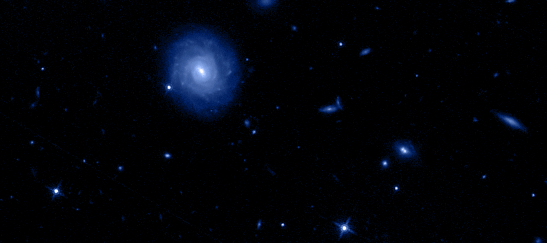
This animation shows in blue the Hubble Space Telescopes Observations in the same area of the Sky as ALMA observations (in red and yellow) of W2246-0526. The big blue galaxy observed by Hubble is located much clores to Earth than the studied system, hence it is not part of this study. The animation clearly shows how ALMA can observe and reveal these stream-structures where the optics telescopes can’t. Credit: T. Diaz-Santos et al; / Hubble Space Telescope / N. Lira – ALMA (ESO/NAOJ/NRAO).
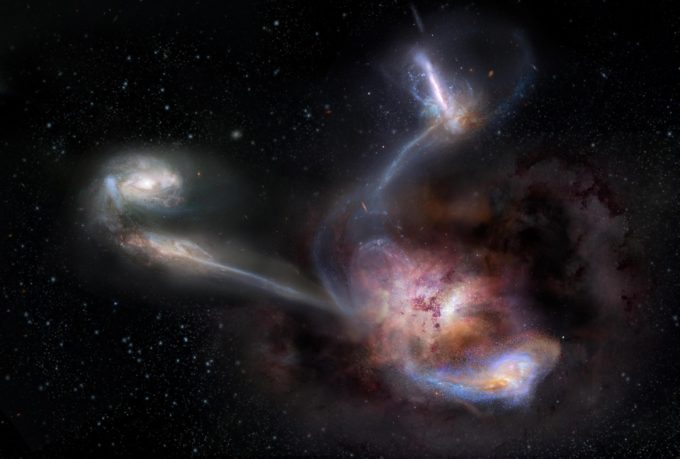
Artist impression of W2246-0526, the most luminous known galaxy, and three companion galaxies. Credit: NRAO/AUI/NSF, S. Dagnello.
Contacts
-
Tanio Díaz-Santos
Postdoctoral Fellow ALMA-CONICYTUniversidad Diego Portales, Santiago, ChilePhone: +56 2 2213 0480Cel: +56 9 9386 0003Email: [email protected] -
Nicolás Lira
Education and Public Outreach CoordinatorJoint ALMA Observatory, Santiago - ChilePhone: +56 2 2467 6519Cel: +56 9 9445 7726Email: [email protected] -
Charles E. Blue
Public Information OfficerNational Radio Astronomy Observatory Charlottesville, Virginia - USAPhone: +1 434 296 0314Cel: +1 202 236 6324Email: [email protected] -
Masaaki Hiramatsu
Education and Public Outreach Officer, NAOJ Chile -
Calum Turner
ESO Assistant Public Information Officer -
Calla Cofield


